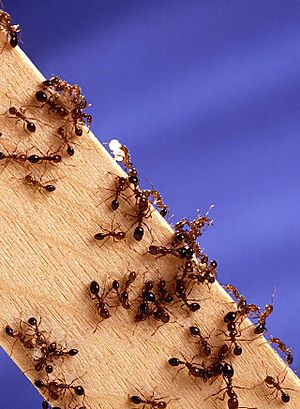Red imported fire ants in the United States facts for kids
The red imported fire ant, also known as RIFA, is a tiny but mighty insect. Its scientific name is Solenopsis invicta. These ants are part of a large group of over 280 different Solenopsis species. While they originally came from South America, they have spread to many other places, including the southern United States. In these new homes, they can be a real problem and even a health risk.
How Fire Ants Arrived
Red imported fire ants first arrived in the United States by accident in the 1930s. They likely traveled on cargo ships from Argentina, landing at the seaport in Mobile, Alabama. A famous biologist named E. O. Wilson reported seeing the first colony in Mobile when he was just 13 years old!
From Alabama, these ants slowly spread across the American South. They now live in states from Texas to Maryland. Since the 1990s, they have also been found in New Mexico, Arizona, and California. In places like California, they probably arrived by truck or ship, not by slowly walking across the land. In a similar way, these ants were accidentally brought to Australia in 2001.
Where Fire Ants Have Spread
In the United States, red imported fire ants have continued to spread north and west. This happened even though people tried hard to stop them. As of 2011, they were found in many southern states, including Alabama, Florida, Georgia, Texas, and Virginia. They are also found all over Puerto Rico.
These ants often travel to new areas by hitching rides in things like grass sod, plants from nurseries, or other farm products. It's hard to get rid of them completely. People can use special products to destroy ant mounds one by one. To truly stop a colony, you need to kill the queens, which can be as deep as 6 feet (2 meters) underground. If the queens are not killed, they might just move a short distance and start a new colony.
Scientists have found that some fire ant groups have adapted. Now, many mounds can have multiple queens living together. This makes them even harder to control. Interestingly, in some areas, larger colonies of another ant species called pavement ants (Tetramorium caespitum) have been seen destroying fire ant colonies. Scientists think this might slow down the fire ants' spread north.
What Problems Fire Ants Cause
Red imported fire ants build mounds that are usually about 18 inches (46 cm) wide and 18 inches (46 cm) tall. However, in some fields, especially where cattle graze, mounds can be over 2 feet (60 cm) high! They often build their homes near houses and other buildings. Sometimes, they even come inside looking for food or water.
These ants can be a big bother. They might sting people who are sleeping or pets. They can also eat vegetable plants in home gardens. They cause the most trouble during hot, dry weather when they look for warmth and moisture in flower beds. If you disturb a fire ant mound, the ants will bite and sting you. Their sting is painful and can leave a red bump.
Fire ants also seem to be attracted to electrical equipment. They crawl into air conditioning units and even the wiring of traffic lights, causing them to short circuit. In Texas, fire ants cause over $140 million in damage each year, mostly from traffic light problems. When ants cause an electrical short, they try to sting the wire. This releases special chemicals that attract even more ants to the problem spot. The best way to protect electrical equipment is to keep ants out physically or use insecticides.
The US government estimates that over $5 billion is spent each year on medical care, damage repair, and ant control in areas where fire ants live. They also cause about $750 million in damage to farms, including vet bills for livestock, lost animals, and damaged crops. Scientists are always looking for new ways to control these ants, like using special fungi or even viruses that can harm them.


